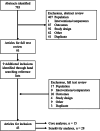The Association Between Overactive Bladder and Falls and Fractures: A Systematic Review
- PMID: 30255417
- PMCID: PMC6223978
- DOI: 10.1007/s12325-018-0796-8
The Association Between Overactive Bladder and Falls and Fractures: A Systematic Review
Abstract
Introduction: Urinary symptoms are associated with an increased risk of falls, but few studies have focused on patients with overactive bladder (OAB). This study aimed to synthesize estimates of the risk of falls and fractures in patients with OAB.
Methods: Medline, EMBASE, the Cumulative Index to Nursing and Allied Health Literature, and Scopus were systematically searched for observational studies that focused on patients with OAB. When available, data from a non-OAB comparison sample were included. Double independent review and data extraction were performed. Falls and fractures data were summarized by unadjusted and adjusted risks, and percent attributable risk (PAR) of falls and fractures associated with OAB.
Results: Fifteen studies were included in the analyses. The proportion of patients with OAB experiencing at least one fall over a year ranged from 18.9% to 50.0%, and the proportion of patients with OAB experiencing recurrent or serious falls ranged from 10.2% to 56.0%. In studies that included a non-OAB comparison sample, a higher risk of falls was observed in patients with OAB compared to those without. A significantly increased (1.3- to 2.3-fold) adjusted OAB-associated risk of falls was reported, while unadjusted PARs for OAB associated falls ranged from 3.7% to 15.5%. Risk was higher among women and those 65 years of age or older. While analysis of fractures showed elevated point estimates, most studies were underpowered to detect a statistically significant difference between groups.
Conclusions: Evidence from the published literature clearly demonstrates the importance of OAB and its symptoms as risk factors for falls and fractures.
Funding: Astellas.
Keywords: Accidental falls; Fractures, bone; Overactive; Review; Urinary bladder; Urology.
Conflict of interest statement
Shelagh M. Szabo is an employee of Broadstreet Health Economics and Outcomes Research (HEOR), a company contracted by Astellas to conduct this study. Karissa M. Johnston is an employee of Broadstreet Health Economics and Outcomes Research (HEOR), a company contracted by Astellas to conduct this study. Katherine L. Gooch was an employee of Astellas at the time of study completion. She is now an employee of Sarepta Therapeutics. David R. Walker is an employee of Astellas. Adrian S. Wagg acted as a consultant to Broadstreet HEOR.
Figures




Comment in
-
Re: The Association between Overactive Bladder and Falls and Fractures: A Systematic Review.J Urol. 2019 May;201(5):866. doi: 10.1097/01.JU.0000554117.78108.94. J Urol. 2019. PMID: 31009974 No abstract available.
References
Publication types
MeSH terms
Associated data
LinkOut - more resources
Full Text Sources
Other Literature Sources
Medical
Miscellaneous

